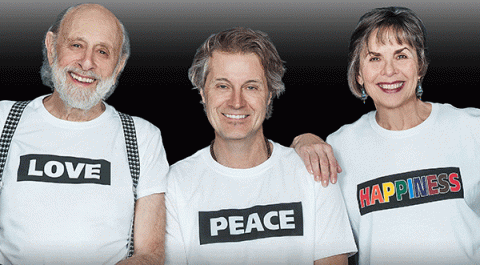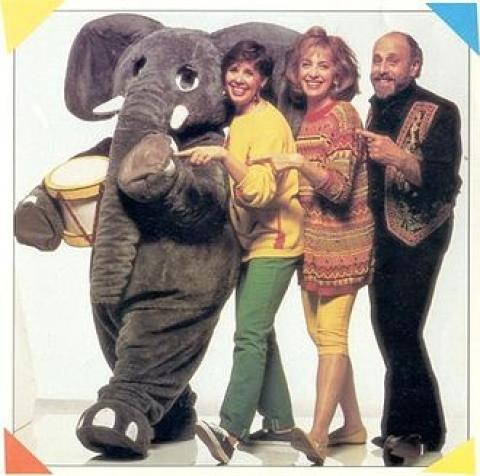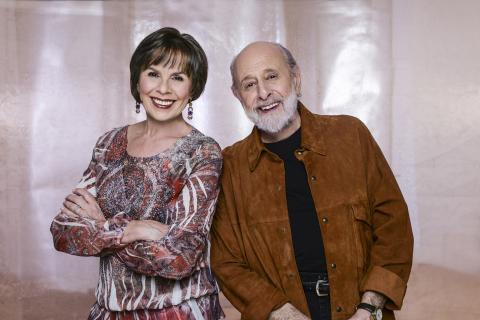
Sharon & Bram just dropped a cover of The Travellers’ “Talk About Peace,” a single featuring Blue Rodeo’s Jim Cuddy written by Sharon’s late husband Joe, and hope to call attention to the long-running YMCA Peace Medal campaign.
The campaign honours individuals or groups who, without any special resources, status, wealth or position, demonstrate a commitment to the values of P-E-A-C-E (participation, empathy, advocacy, community, and empowerment) through contributions made within their local, national or global community, according to the web site.
Since it was created in 1987, more than 1,900 individuals and groups across Canada have been recognized for their peacebuilding work with YMCA Peace Medals, Sharon & Bram honoured recipients of the program before a May 4 event in Saint John, New Brunswick, who joined them on the choruses to encourage the audience to snap and sing along.
With the arrival of their 40th anniversary, Canadian music legends Sharon Hampson and Bram Morrison, best known as Sharon & Bram, are retiring from the touring life following one last cross-Canada jaunt in 2019.
When they first formed in Toronto in 1978 as the trio Sharon, Lois & Bram with Lois Lilienstein, they had to borrow $20,000 to record One Elephant, Deux Éléphants, an album of largely traditional music that became one of the fastest selling children’s music albums of all-time, placing them in a realm occupied by another Canadian pioneer in the field, Raffi.
More than 25 albums followed, as did five years of The Elephant Show on CBC TV and later, Nickelodeon in the U.S., as Sharon, Lois & Bram took the children’s entertainment world by storm.
In 1998, following the death of her husband, Lois Lilienstein decided to retire from the group. She died of cancer in 2015. but Sharon & Bram have soldiered on, continuing to thrill audiences of all ages. There will also be new Sharon, Lois & Bram book called Skinnamarink, about the iconic song that was adapted from a traditional public domain ditty, to be released next fall.
While the pair are adamant that they don’t “do lessons for children through our music” or choose songs about issues — their cover songs are fun, about things like peanut butter and jelly, bees, elephants, and love (ie. skinnamarinky dink a dink, skinnamarinky doo, I love you).
Sharon and Bram talked with Samaritanmag about 40 years of making a difference, selected their songs, visiting children in hospitals and their roles as UNICEF ambassadors, the global organization that “works across 190 countries and territories to reach the most disadvantaged children and adolescents – and to protect the rights of every child.”

Sharon Hampson: We’re happy to be here and healthy.
Did you think the Sharon & Bram phenomenon would last this long?
SH: God, no.
Bram Morrison: We figured one record, that was it.
SH: We didn’t decide to make a career. We just decided to make a record together. We initially went back to doing individual work, but that didn’t last too long.
BM: We found out very quickly that people started expecting things and we were more than happy to fulfill that doing a record a year. We did that for a number of years for the first half of our career.
SH: Our record came out in the fall of 1978 and of course, we started touring and traveling. In January 1979, we were invited to come to the Vancouver’s Children’s Festival the following May. That really was the turning point for us because we discovered that people knew us and liked what we were doing.
Did Sharon, Lois & Bram always target children’s music?
BM: Yes. That’s what we chose from the very beginning, although it was not going to be children’s music, per se, but family music. As a matter of fact, we decided that everything we did was aimed at the family, not just the children. The subtitle for One Elephant, Deux Éléphants, was, “a children’s record for the whole family.” That’s been the subtitle of everything that we’ve done since.
How did you first know you were reaching kids?
BM: We started out solo, on our own, working with children. I worked with children as an artist and I was a sixth-grade teacher for a number of years: I was an itinerant going from school to school. So know that I certainly had a lot of experience with children over the years and so did the other two.
SH: We did. Lois started doing music in the libraries. She started in a pre-school program that her son was in and she started doing music that way. In the very beginning, I started out sitting on a stool in a coffeehouse singing for grownups. But it was not very long until I found my way into the community of musicians for children and realized that I belonged there and I was comfortable there. We spent most of our lives working with children and families and that suited us.
BM: That’s what brought us together. It’s not like we were three people who got together and said, ‘Hey, what are we going to do now?’ We knew what we were going to do.
What were some of the early issues you found that were important to children? Society seems much more sophisticated today, especially in terms of technology. Kids seem more easily distracted these days due to mobile phones, big screen TVs etcetera.
BM: That’s true, but once you get them into a live situation or listening to recordings and away from their screens, they’re just like kids were in our generation.
SH: We did not write songs. We were collectors of music, of different kinds of music. We chose our music based on the music itself. Do we like this song? We’re going to sing this song. We did not do lessons for children through our music. As it happens, of course, children are learning all the time. We were careful about not presenting something inappropriate, but our rule was to bring music into the lives of children and their families so that they could have it forever.

SH: That’s exactly what our audiences are now – it’s quite astounding. There are people in the audience who bring babies, because babies are their excuse for coming, There are people in the audience who don’t have children yet, but they grew up on us, and they come. We find that 30-somethings often populate our concerts. They thank us and they tell us what we have meant to them. People say, ‘I’m a professional musician because of you’ or ‘I sing your songs all the time with my children.’ We get this glorious feedback.
BM: Up until recently, we thought we’ve now connected with three generations. But just this past year a woman said, I’m bringing my great grandchildren,’ so now it’s four.
You have toured internationally.
BM: Just Canada, the United States and Bolivia, South America… but that was something else.
SH: For UNICEF.
BM: Yes, that was part of our UNICEF activities
How did you UNICEF association begin?
SH: It started on our 10th anniversary, which was 1988, and we felt that we had a really wonderful stretch and that we should do something to give something back. They approached us and we were happy to participate with them. We spent many years particularly supporting their Halloween fundraising program. We would do promotions, videos and them available at many of our concerts around Canada.
BM: When they decided they wanted to shoot an hour-long TV special about how they operate in the Third World, they chose a native village in Bolivia and they sent us there to do two things — first, to observe as to what UNICEF was doing which was incredibly important- educating women and girls about how to care for babies.
SH: How to weigh them. How to feed them. It was amazing.
BM: And how to dig wells in the village for fresh water – many things that we take for granted. It was kind of new to them. They asked us to come and observe and comment about it, but also to entertain the families - which was really interesting, because they spoke no English. They had their native language, which I think was Quechua, and some of them, the younger ones, had Spanish. The older ones didn’t even have Spanish. As a matter of fact, I spent time in Latin America prior and my Spanish wasn’t bad, but it was a lot better than some of the adults there.
SH: So, that was quite an experience and it was thrilling. And we learned a lot about the work UNICEF does, and we were fairly impressed with how they operated. They just didn’t do for the locals, they helped the locals learn to do for themselves. They gave them the tools and I think that’s a very impressive way to help.
As ambassadors, what were your roles?
BM: We did public service announcements for them.
SH: During Halloween, kids would come to my door and if they didn’t have their UNICEF boxes, they would hear from me: “Where is your UNICEF box?” We also went to the United Nations for UNICEF’s 50th Anniversary.
BM: They didn’t call it a celebration, because celebration is about accomplishment, about finishing something. But they weren’t finished, not anywhere near.
SH: But we presented at the United Nations General Assembly. We sang and we received the Danny Kaye Award on another occasion. So basically, we tried to spread word about the good work of UNICEF.
What other charities were you involved with?
BM: Well, in the United States, for a brief time we were associated with a group that promoted and provided breakfast at schools for children who came to school hungry. They came to realize that if you’re hungry, you ain’t learning. So, we spent some time promoting that idea in the United States for it. It wasn’t a long-term thing.
SH: We supported some breakfast programs here locally as well. They’re so important.
BM: We were also the spokespeople for the Yes vote of getting your children inoculated.
SH: That was an interesting experience for us. There was a small,…
BM: But very vociferous…
SH: …community of people who disapprove of vaccinations. We believe they are very wrong, but we did hear from them. We were very involved with that program. We did a lot of research before we agreed to do it – we talked to appropriate people and resources to make sure we were making a good decision. And then we did radio and TV PSAs and we did posters that were posted in many doctors’ offices around the country,
You visited children in hospitals.
BM: Whenever there were people in the towns and we had time, we made sure that we got into hospitals to see children, both on a chronic and on an outpatient basis. We had a great time with them.
What kind of impact did you feel you made with those visits?
BM: Those kids were in constant pain. We especially remember kids in the burn unit.
SH: That was in Winnipeg and that is such a profound memory for me and that’s a long time ago. We saw those kids in the burn unit wear these stretchy coverings on their face, so you can see the face, but it’s hard to identify an individual person. It was the same year and at one point, we were leaving after a show, and there were a bunch of kids getting into a vehicle who were wearing those coverings. They obviously came from the burn unit. It was very impactful for us.
BM: I don’t remember that, but I do remember going back to the same hospital a year later and seeing the same kids wearing the same dressings. It’s a very long heal, if one ever does heal.
SH: We’ve done little hospital runs as well, where we’ll be in a room where the children are brought down to be entertained. Some of them are really suffering and it’s hard to be happy and some of them are distracted by what we do. We really try hard – when it’s a small group – to reach out to them individually and if we can bring a little happiness to them, boy oh boy – it’s not clear who has the bigger reward in that case.
You’re about to embark on your final tour, but it’s not the end of the road for Sharon & Bram.
SH: We recorded four new pieces of music. The first one is called “The Colour Song.” We have two others over the next few months, “The Hug Song’ and the other “Talk About Peace.” Also, ‘Skinnamarink,’ which is our theme song — it’s been our closer for over 40 years. The thing about ‘Skinnamarink ‘is that in the fall of 2019 there will be a new book called Sharon Lois & Bram’s Skinnamarink and it has additional words, an introduction and other versions and it’s a song about all kinds of people in all kinds of places with all kinds of feelings. It’s a song about diversity. The book is beautifully illustrated by Ken Lang and it’s lovely and we’re very proud of it.
Speaking of the new songs, these are healing songs speaking about issues?
BM: Certainly, "Talk About Peace," which is a song that Joe Hampson wrote back in the ‘60s when people were writing and singing about political issues and we thought, well, if we sing that song and others like it enough, we’re going to fix things up and everything will be okay.
SH: Guess what? Didn’t’ happen. So, we thought that was an important song to include. “The Colour Song”’ is certainly not a message. It happens to be teaching something and the audience has taken to it beautifully and are singing along with it instantly. Eventually, the kids will understand when Bram says it’s about homonyms, and they will understand what it means, but for right now they don’t need to. ‘The Hug Song’ is just about giving people a chance to hug.
Are children facing different issues today?
BM: No.
SH: We don’t do music that talks to issues. But it’s interesting, I reminded that a number of years ago there was a lot of talk around children not being touched and not hugging. I think there’s a serious problem. I think a lot of children need to be hugged and teachers at school are hesitant and are prevented to because they are afraid they’re going to be accused of something. Children approach us all the time wanting to be hugged – and a lot of times if it’s a little girl, Bram will check with the parents first.
BM: First, I check with the kid.
SH: One has to be more careful now. We have an impulse to hug children. We like children. We enjoy them. It’s a natural for us to be connected in that way, but one has to be careful these days.
What will you miss most about the road?
SH: You get up on the stage and you get all this love flowing at you – it’s glorious. It’ll be sad to give that up.
BM: Each of these songs we’ve recorded is going to be a release and will end up with us involved being there. It will go on for a while.
SH: The day we stop touring, we’re not going to stop singing, and there will be occasions where we’ll be invited and hopefully, we’ll be able to do some of that as well.
(Please support Samaritanmag's original journalism by making a PayPal contribution or EMT transfer using info@samaritanmag.com so we can increase the amount of content and writers we hire. Samaritanmag is the anti-tabloid, covering good people trying to change bad things. Let's make this thing bigger than TMZ.)
30 Winter Outfit Ideas to Kill It in 2020 - Fashion Inspiration and Discovery